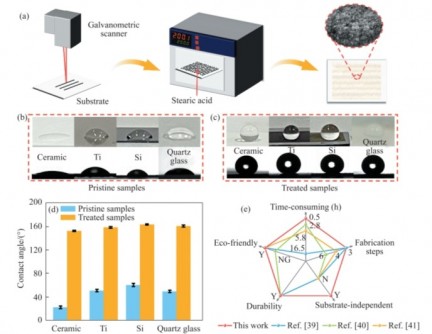Newswise — Superhydrophobic surfaces, characterized by their ability to repel water with a contact angle above 150° and a sliding angle below 10°, offer a range of applications from self-cleaning and anti-corrosion to oil/water separation and droplet manipulation. Traditionally, creating such surfaces has been challenging, requiring complex, time-consuming, or material-specific methods. Recent advancements, however, include innovative techniques like 3D printing for adjustable porosity, hydrothermal methods for antibacterial coatings, and soft-imprinting for lotus-inspired textures. Despite these developments, a need for simpler, versatile methods persists.
A new study ( doi:10.1007/s11771-023-5527-x ) released on 19 January 2024, in Journal of Central South University focused on a novel technique for creating superhydrophobic surfaces that can repel water effectively.
This new method for creating water-repellent surfaces has two main steps. First, a special laser (femtosecond laser) is used to carve tiny patterns on different materials. This carving is really detailed, making small structures that help enhancing surface roughness. Next, these laser-carved surfaces are coated with stearic acid, a substance that makes them water-repellent by reducing surface energy. This combination of laser carving and chemical coating creates a strong water-repellent surface. What's great about this method is that it can be used on many different materials like metals, ceramics, and plastics, making it more versatile than older techniques. This could be really useful for things like keeping electronic devices safe from water or improving medical tools.
Professor YIN Kai, the lead researcher, stated, "Our femtosecond laser-chemical hybrid processing technique marks a significant advancement in material science, offering a versatile approach to creating superhydrophobic surfaces on varioussubstrate."
The femtosecond laser-chemical hybrid processing technique represents a leap forward in the creation of superhydrophobic surfaces, with potential implications across a broad range of fields. By enabling the application of superhydrophobic coatings on variousmaterial, this research paves the way for innovations in surface science and technology.
###
References
DOI
Original Source URL
https://doi.org/10.1007/s11771-023-5527-x
Funding information
The National Key R&D Program of China Projects (2023YFB4604200); The National Natural Science Foundation of China Projects (52222513, 52075557); The Natural Science Foundation of Hunan Province, China Project (2021JJ20067); The Science and Technology Innovation Program of Hunan Province, China Project (2021RC3011); The Central South University Innovation-Driven Research Programme, China Project (2023CXQD019); The State Key Laboratory of Precision Manufacturing for Extreme Service Performance, Central South University, China Project (ZZYJKT2023-12); The State Key Laboratory of Intelligent Manufacturing Equipment and Technology, Huazhong University of Science and Technology, China Project (IMETKF2024018).
About Journal of Central South University
Journal of Central South University publishes original academic papers representing the latest research in various engineering fields. The Journal mainly publishes original academic papers which represent the latest research achievements in such fields as materials science and engineering, metallurgical science and engineering, mineral processing, geology and mining, chemical engineering, and mechanical, electronic and information engineering.
Journal Link: Journal of Central South University, January 2024
